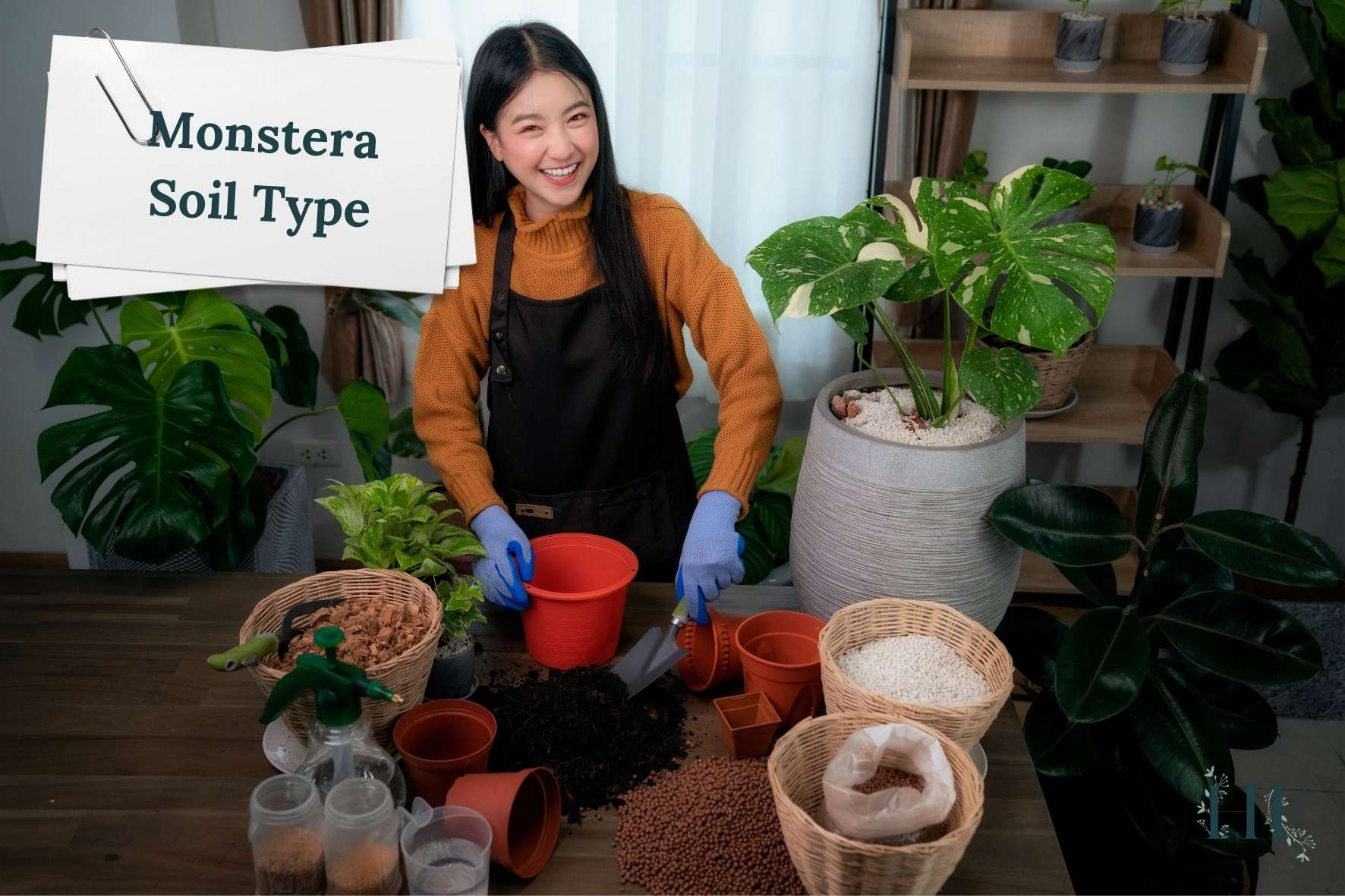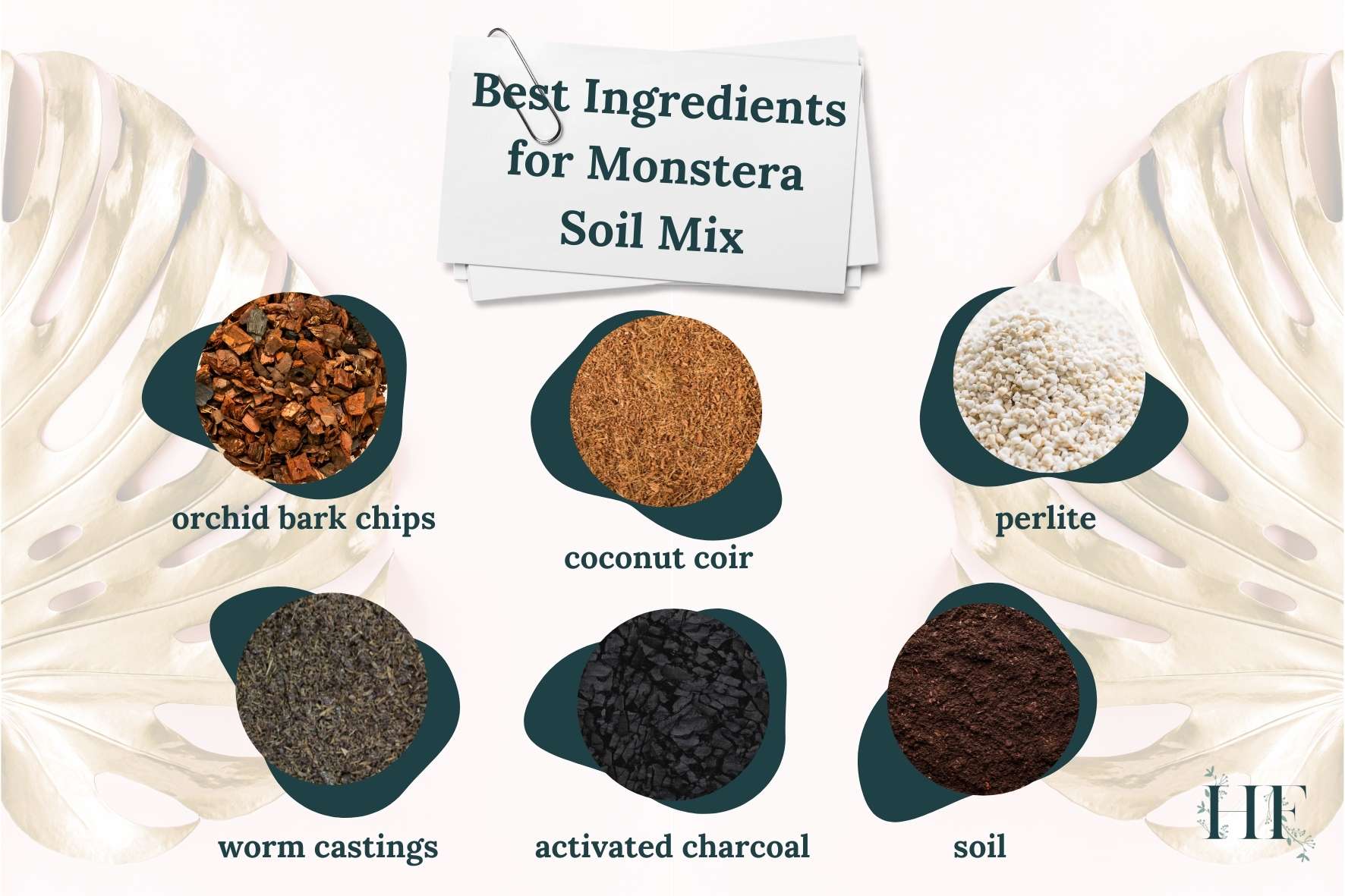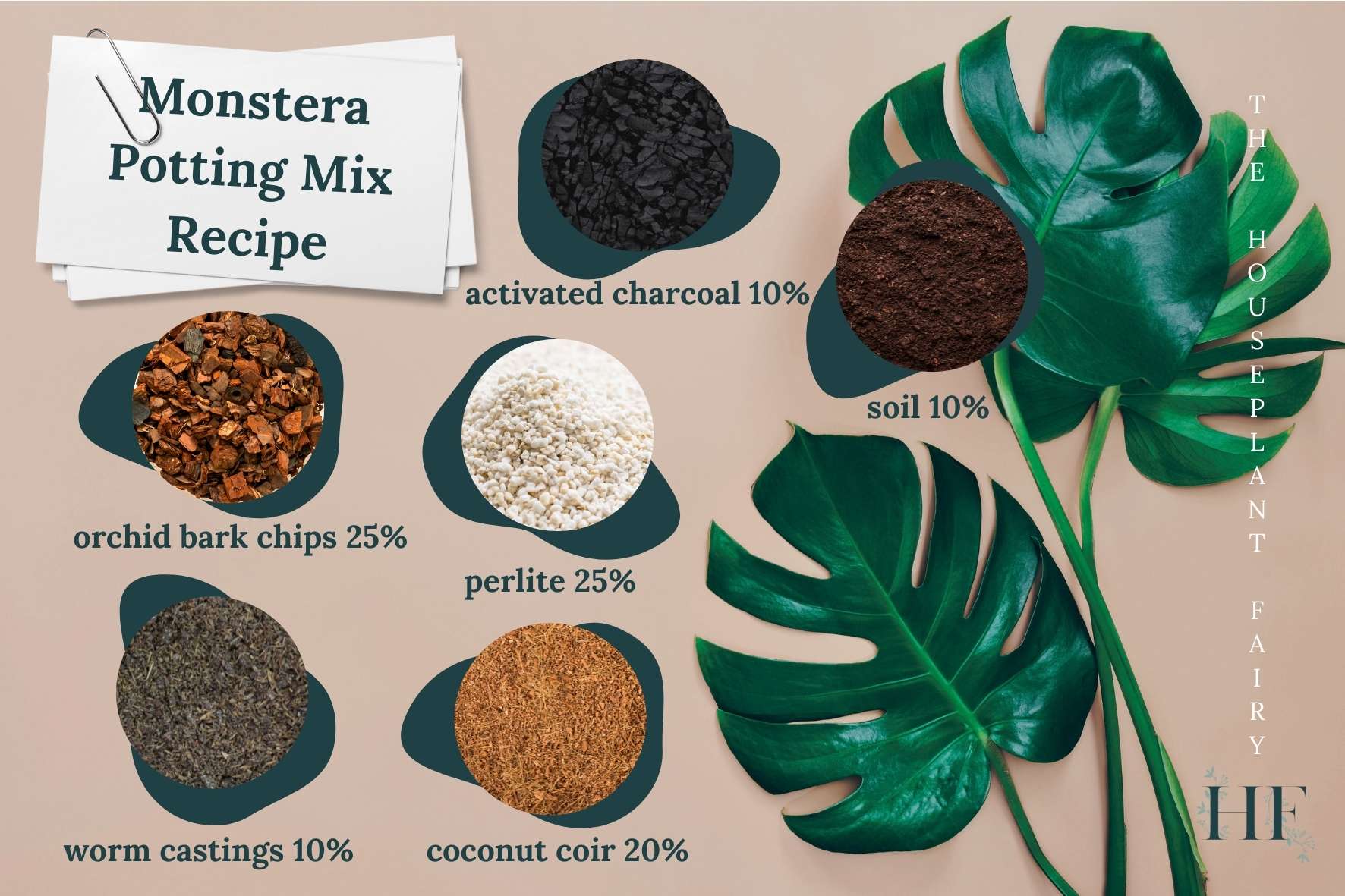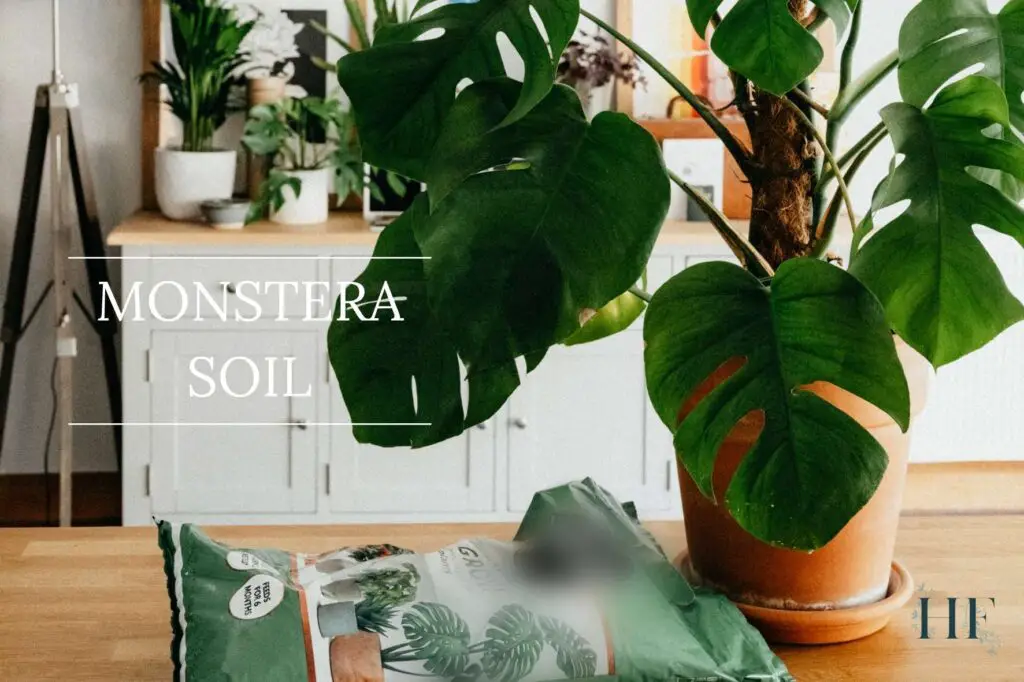If you are you wondering which soil type is best for your Monstera or you are considering making your own Monstera soil mix, then you should know:
Monstera plants do best in well-drained and aerated soil. They prefer a slightly acidic soil type, with its pH in the range of 5.5 to 7. A potting mix containing orchid bark chips, coconut coir, perlite, and worm casting, apart from the soil, is a perfect mix for the Swiss Cheese Plants.
Here are a couple of recipes for Monstera potting mix, including what factors to take into account when choosing soil and other ingredients for your Monstera plant.
Factors When Choosing Monstera Soil
But why does the soil choice matter?
If you choose a potting mix that doesn’t suit your Monstera plant, it will struggle to obtain what it needs, which can lead to serious issues.
When choosing a Monstera soil mix, you want to take these 5 factors into account:
1) Drainage
Monstera Deliciosa is particularly susceptible to root rot. Hence, drainage is the most crucial aspect to consider when choosing the type of soil.
Apart from potting your Monstera in a pot that has good drainage, the soil mix also needs to be well-draining.
Good soil drainage allows water to move through the soil at a moderate rate without puddling, so your Monstera has time to properly absorb the water through its roots.
When soils drain too fast, plants are not able to properly absorb the water. While slow drainage may lead to root rot.
For soil to be able to drain, it must contain particles that differ in size. That’s why you want to add different ingredients to your potting mix (which I will mention further down).
When using just soil or ingredients of similar size as the potting medium, these will clump together and compact the soil. This will leave the plant with drowning roots and no drainage.
2) Aeration
Aeration in the soil is also important since it allows for a more even distribution of moisture. And more importantly, it helps with the flow of oxygen through the Monstera plant’s roots.
Good aeration means that there’s enough air in the soil to allow for proper drainage and airflow around the roots.
If the soil is too compacted and damp all the time, the roots may never be able to access the much-needed oxygen and excess moisture can lead to root rot.
That’s why you also want to keep the soil light, not dense, to avoid compact soil. This will allow the roots to grow freely without cramping them in hardened soil.
Both aeration and drainage are a 2-in-1 package. The same soil ingredients that improve drainage also improve aeration. Ingredients like perlite and bark help to keep the soil well aerated.
3) Moisture (Water Retention)
Although Monstera plants like well-draining and aerated soil, they don’t want the soil to dry out. Monsteras also need soil with good water retention, so it stays moist.
A well-draining soil is not contradictory to soil with good water retention.
When talking about water retention, we are talking about the soil’s ability to absorb water and slowly release it as the roots require it.
The key is to balance aerating ingredients like perlite with more dense materials that absorb water, like coco coir, bark, and compost.
This way, the soil is kept moist without the risk of excessive dampness.
Of course, you might use a balanced Monstera potting mix but find the soil is drying out too quickly or is too wet. This is due to underwatering and overwatering issues, which can be prevented by watering your Monstera properly.
4) Nutrition
In nature, plants have access to all kinds of nutrients through the soil (which includes dead plant debris, animal droppings, and worms castings), rainwater and air. But indoors, they have access to a limited amount of soil inside their pot.
So, Monsteras must obtain the necessary mineral nutrients (nitrogen, phosphorous, and potassium, to name a few) from their growing medium so they grow bigger and healthier, putting out new leaves, including fenestrated ones.
Compost and worm castings are the primary nutrient sources for Monstera. Also, your plant will need fertiliser to replenish the nutrients in the soil mix.
You can find more about Monstera nutrients here, which also includes tips on when and how to fertilise your plant.
5) Soil pH
Different plants thrive in different soil pH levels.
So, what soil pH is best for Monstera plants?
Most Monstera plants prefer soil that is slightly acidic, with an ideal pH range of 5.5 to 7.
The pH scale goes from 0 to 14. A neutral pH is 7.0, any number below this is considered acidic and anything above 7 means the soil is alkaline.
A soil’s pH depends on what it’s made of and how much water it receives.
Soil pH plays a role in your Monstera’s growth and nutrient uptake, and it can also affect the balance of bacteria in the soil.
I use this 3-in-1 soil meter to measure the soil’s pH level as well as moisture and light levels.

Monstera Soil Type
So, which soil is best for Monstera?
Since Monsteras are an aroid plant, they need good aeration and drainage. The soil mix should be light, chunky and breathable. Most Monstera plants do best in an aerated and well-draining soil mix with a pH of 5.5 to 7 (i.e., slightly acidic).
The best way to achieve that type of medium is to use a mixture of indoor potting soil, a handful of orchid bark chips, loose coco coir, perlite or even some organic matter like worm castings.
Alternatively, you can also add a ready-to-go mix of coco coir and perlite into the houseplant compost.
There’s also a Monstera-specific potting soil available on Amazon.
Continue reading to find out some Monstera soil mix recipes that you may want to try next time you are repotting your Monstera.
Making Your Own Monstera Soil Mix
If you decide to make your own soil mix, there are some advantages to it:
- You choose what ingredients go into the mix, depending on what is best for your Monstera.
- You can also choose or afford to buy higher quality compost or soil, since you won’t be needing as much.
- The potting mix will last longer since you are carefully selecting its ingredients according to their benefits and nutritional value.
- It will be predominantly safer since you can avoid certain chemicals that are inside some of the commercial soil mixes.
That being said, let’s look at the ingredients you could consider.

Best Ingredients for Monstera Soil Mix
Here are the main ingredients for making your own soil mix for Monsteras:
1) Orchid Bark Chips
Bark chips are great for both aeration and drainage.
They are shredded or chipped tree barks. Apart from providing the soil with extra nutrients, their coarse nature helps aerate the soil, preventing it from compacting and adding a drainage component into the mix.
I use these orchid bark chips.
2) Coconut Coir
Coconut coir is great for water retention (i.e., keeping the soil moist).
It’s a natural fibre extracted from the outer husk of a coconut. It can absorb water up to 10 times its weight. That’s why it’s a good ingredient for water retention and adding moisture to your soil.
This is the loose coco coir I use for my houseplants.
An alternative to coco coir is sphagnum peat moss. However, peat moss decays quickly, causing the soil to compress, lose drainage, and build up harmful salts. Also, peat moss becomes hydrophobic (meaning it repels water) when dry.
3) Perlite
Perlite is great for drainage and aeration.
It’s a volcanic glass that occurs naturally. Perlite is coarse, pebble-like rock that is highly porous.
Although it can hold some moisture, it allows most water to drain through. Perlite modifies the soil substructure to be less compact when it dries, aiding with aeration and drainage.
I recommend this perlite.
Pumice can also be used instead of perlite. It’s also a volcanic rock and since it’s inorganic, it doesn’t attract or host fungi or insects.
Since perlite is a non-renewable resource, plus both perlite and pumice need to be mined, you can alternatively use gravel.
4) Worm Casting
Worm castings are great for adding nutrients to the soil.
This is an organic fertiliser produced from earthworms when they eat their way through the soil.
Worm castings contain nutrients and beneficial microbes to help your Monstera plant grow.
I recommend this organic worm castings fertiliser.
5) Activated Charcoal
Activated charcoal is great for decontamination.
Horticultural charcoal is made of burned bark. When heat treating charcoal at high temperatures, it activates it.
Activated charcoal can absorb chemicals like chlorine (which can be found in tap water). It is also anti-bacterial and anti-fungal, which helps to prevent root diseases.
It repels insects, prevents mould and absorbs excess water (preventing root rot).
6) Potting Soil
Finally, what kind of soil should you get?
You can go for an organic potting mix or a Monstera-specific potting soil. Alternatively, you can use regular potting soil.
Just bear in mind that although most have similar ingredients, their proportions will differ from one potting mix to another.
A commercial potting mix is composed of peat moss, coconut coir, grit, sand, vermiculite, and perlite.

Monstera Potting Mix Recipes
Now that you know the ingredients needed to make the perfect soil mix, let’s talk about the measurement for each ingredient and how to go about mixing it.
Advanced Monstera Potting Mix Recipe
Ingredients:
- Orchid bark 25% or 3 parts.
- Coconut coir 20% or 2 parts.
- Perlite 25% or 3 parts.
- Activated charcoal 10% or 1 part.
- Worm Casting 10% or 1 part.
- Soil 10% or 1 part.
How to mix it:
- Place the required quantity of each ingredient into a mixing bowl.
- Mix the ingredients with a gardening spoon until you get a well-balanced mixture.
Insider Tip: The easiest way to follow a ratio recipe is by using the same size scoop for each ingredient. Then, just add the specified number of scoops to your mix. For example, you would use 3 scoops for bark, 2 scoops for coconut coir, etc. to end up with a total of 11 scoops of Monstera potting mix.
Simple Monstera Potting Mix Recipe
For a more simple but balanced potting mix, you can combine potting soil and perlite in a ratio of 3:2 (three parts soil to two parts perlite), which means 60% soil and 40% perlite.
Alternatively, you can go for 50% soil and 50% coco coir and perlite mix (which is ready-to-go).
Tips for Making Soil Mix for Monstera
When choosing ingredients, apart from taking into account the factors I mentioned in the beginning, there are other scenarios that will influence your choice:
1) Different Environments Need Different Ingredients
Room temperature and humidity will have an effect on how quickly moisture will evaporate from your soil.
If you live in a hot climate, you can put sphagnum moss or decorative pebbles on top of the soil to retain the moisture, which would otherwise evaporate quickly.
Read also: Monstera Humidity & Temperature Needs – 7 Tips to Get It Right.
2) Your Watering Habits Change the Ingredient Mix Ratio
How much you water your Monstera will also affect the soil.
If you tend to overwater your Monstera, which will cause root rot, it is best to add extra perlite into the soil mix. This will help to better aerate the soil and flush excess water, preventing root rot.
On the other hand, if you are more likely to underwater your Monstera, which will cause the plant to shrivel and die, consider adding less perlite.
Here is A Guide to Monstera Water Needs (How Often and When), an in-depth blog post about watering your Monstera.
3) Top Dressing the Soil Mix of Monstera to Keep Pests Away
Top dressing your Monstera (and other houseplants) has two benefits:
- Keeps pests away, such as gnats. These tinnie flies are attracted to the moisture of your soil, they lay their eggs in it and they can be a pain to get rid of.
- Looks aesthetically more pleasing.
Mainly, I decided to top dress my indoor plants due to gnats. Apart from my plant display looking more appealing, it also helps to retain moisture. I use these decorative pebbles.
Alternatively, you can use an inch of orchid bark, or two inches of sphagnum moss.
You can top dress anytime, or do it after you prepare your Monstera repotting soil!
Read also: A Guide to Repotting Monstera (When, Why and How).

